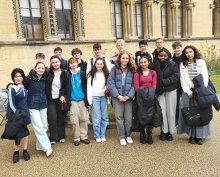
By Sonia Erwig (Lower Sixth)
On Friday 27th September, our IB Diploma class had the opportunity to visit the Pitt Rivers Museum in Oxford as part of our Theory of Knowledge (TOK) studies. It was a joint trip with Bedford School, where we were given a chance to examine a collection of cultural artefacts from all over the world. The museum helped bring to life many of the abstract concepts we've been discussing in TOK over the past couple of weeks. It was really interesting to hear how they interpreted some of the same topics we’ve been working on in our TOK classes—particularly around the nature of knowledge and the different ways it can be described through forms of media like painting and labelling.
The Pitt Rivers Museum was also extremely thought provoking since instead of displaying objects in chronological order or by region, everything was grouped by type, for example tools, clothing, or religious items were all presented together. This raised interesting questions about how knowledge is categorised while teaching us that information is often stored in symbols or materials present on physical artefacts rather than in a written format.
In addition to the museum's unique layout, we were also encouraged to think critically about how the artefacts were collected and displayed, and what this says about the role of museums in shaping our understanding of history and culture. Many of the objects came from colonial contexts, which sparked discussions about the ethics of ownership and representation. These questions added a deeper layer to our conversations, pushing us to consider how power dynamics influence not just what we know, but how that knowledge is presented to us.
This trip provided valuable insights into our curriculum that will be useful for our TOK exhibits later this academic year, as it challenged us to think critically about how knowledge is represented and interpreted. We can then apply this thought process again when we are considering our own chosen objects for the exhibition.





















